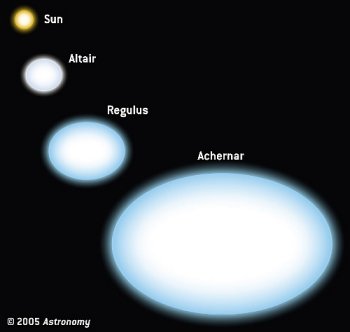Regulus (Alpha Leonis)

Comparison of stars flattened by their fast spin.
Regulus (Alpha Leonis) is the brightest star in the constellation Leo and the 21st brightest star in the sky as seen from Earth. Regulus is a bluish-white B star; its Latin name means "the little king" – the reference to a kingly star going back to ancient times. Regulus marks the bottom of the Sickle that outlines the Lion's head, and lies almost exactly on the ecliptic so that it is regularly occulted by the Moon.
Regulus is a main sequence star like the Sun that generates light by converting hydrogen into helium at its core. However, Regulus is more massive, so it shines brighter, hotter, and bluer. With a spectral type of B7 and a distance of 77 light-years, it's the closest B-type main-sequence star to the Sun.
Regulus is orbited by a distant binary pair – an orange dwarf and a red dwarf. These fainter, lower-mass companions go around Regulus at a distance of about 4,200 astronomical units (AU) and with a period of at least 130,000 years. They are themselves separated by at least 95 AU in a 1,000-year orbit. Both these companions of Regulus are less massive and dimmer than the Sun.
In 2008, Douglas Gies of Georgia State University and colleagues found that Regulus also has a much closer, faint companion. This unseen star gave away its presence through its gravitational pull, which causes Regulus to wobble to and fro. The companion has a third of the Sun's mass, orbits Regulus every 40.1 days and is only 52 million kilometers it – slightly closer than Mercury is to the Sun. It seems likely that it is a white dwarf.
Fast spin, flattened shape
Regulus has an extremely rapid rate of rotation. Its equatorial rotation velocity is 317 kilometers per second (709,000 mph), compared with the Sun's 2 kilometers per second (4,470 mph).1 Whereas Sun takes a month to spins once around, Regulus dos the same in 15.9 hours. If Regulus spun just 10% faster, researchers estimate, it would fly apart.
This rapid rotation flattens Regulus into a pumpkin shape. Its equatorial diameter is 32% greater than its polar diameter: the former is 1.65 milliarcsec and the latter 1.25 milliarcseconds. At Regulus' distance, these numbers translate into actual equatorial and polar diameters of 4.16 and 3.14 solar diameters, respectively. The distortion results in a big difference in surface temperature of the star between poles (15,400 K) and equator (10,300 K). Furthermore, because the poles are so hot, the star shines brightest there. The equator radiates only 20% as much light per square inch as the poles do. Previously, this phenomenon of gravity darkening had been seen only in the case of eclipsing binaries.
The same team that discovered the close companion star in orbit around Regulus also suggested it was the source of the primary's flattening. Material shed by the companion during its red giant phase may have been dumped onto Regulus, giving rise to a large equatorial bulge.
| visual magnitude | 1.36 |
| absolute magnitude | -0.52 |
| spectral type | B7V + K1-2V + M5V |
| surface temp. (mean) | 12,000 K |
| luminosity | 240 Lsun |
| radius (mean) | 3.5 Rsun |
| mass | 3.4 Msun |
| age | ~ 50 million yr |
| distance | 77.5 light-years (23.8 pc) |
| position | RA 10h 08m 22.3s, Dec +11° 58' 02" |
Other fast spinners
Regulus isn't the first bright star found to be extremely flattened because of its rapid spin. In 2001, astronomers reported that fast-spinning Altair, a white star of spectral type A7, has an equatorial diameter 14% greater than its polar diameter. And in 2003, astronomers discovered the equatorial diameter of the blue B3 main sequence star Achernar is 56% greater than its polar diameter, making it flattest star known.
Reference
1. McAlister, H. A., ten Brummelaar, T. A., et al. "First Results from the CHARA Array. I. An Interferometric and Spectroscopic Study of the Fast Rotator Alpha Leonis (Regulus)." Astrophysical Journal, vol 628, part 1 (2005), pp 439–452.


